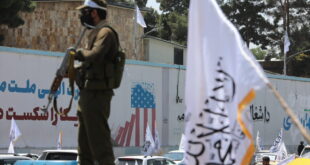Taliban’s repudiation of Pakistan’s position on the Durand Line challenges a pillar of Pakistan’s security policy.
In at least two incidents in late December and early January, Afghan Taliban soldiers intervened to block an ongoing Pakistani project to erect fencing along the shared border between Afghanistan and Pakistan — the demarcation of which prior Afghan governments have never accepted. Despite attempts to resolve the issue diplomatically, and the Taliban’s dependence on Pakistan as a bridge to the international community, both sides remain at odds over the fence. USIP’s Richard Olson, Asfandyar Mir and Andrew Watkins assess the implications of this border dispute for Afghanistan and Pakistan’s bilateral relationship and the region at large.
Does the Taliban have an established position on the Afghanistan-Pakistan border, or is this a new stance on their part? How much of a sticking point might this issue prove to be in future bilateral relations?
Olson: It was perhaps inevitable that despite the Taliban’s historic reliance on Pakistan for support, there would be a break with Islamabad over the question of the Durand Line border between the two countries. The Taliban asserts a right to free movement of peoples across the colonial era frontier, consistent with the position of not recognizing the line as an international boundary it took in the 1990s. All Afghan governments since 1947 have taken similar positions on this dispute. The issue may be further complicated by the fact that — apart from the issue of recognition — Pakistan demarcates the Durand Line differently from Afghanistan, and thus portions of the Pakistani fence may lie within what Afghanistan (and most of the international community, including the United States) would consider Afghan territory.
Pakistan has downplayed the clashes on the line, publicly calling for a diplomatic resolution to the issue, thus also recalling its own position of the 1990s. But for Islamabad, the question of unrest in its own Pashtun territories looms much larger now than it did three decades ago, since the former Federally Administered Tribal Areas have been a source of terrorism and instability throughout this century. Kabul’s allowing of a de facto safe haven for the Pakistani Taliban (Tehrik-e-Taliban Pakistan; TTP) is already a large irritant in the bilateral relationship. If Islamabad perceives that the Afghan Taliban has moved beyond asserting a traditional position on the Durand Line to actually supporting a revanchist movement to reclaim lost Pashtun lands, the relationship may well break. Already Islamabad is ascribing the TTP’s renewed strength to Indian machinations, so the regional implications of this conflict are potentially large.
How much of an impact has Pakistan’s border fencing project had on its internal security? How does the Pakistani military now view the situation on its western border following the Taliban takeover, and how does this fence fit into its security priorities?
Mir: Pakistan’s fencing of the Afghanistan-Pakistan border has been a central project of Pakistani Army Chief Gen. Qamar Bajwa’s security policy for the country’s western frontier. Given Pakistan’s fiscal constraints, it has been very costly for Pakistan in material terms. There are reports that Pakistan has spent nearly $532 million on the project. Pakistan appears to have had two major political goals with the fencing effort: to control cross-border movement of goods and people across what has long been a porous border, as well as to offer a demarcation fait accompli on a border which has been rejected by prior Afghan governments. While the movement of illicit goods hasn’t slowed down, the movement of civilians and migrants appears to have become largely restricted to declared border crossings.
The demarcation fait accompli objective is important. When done bilaterally, demarcation of borders involving one or more post-colonial states tends to be generally contentious and drawn out. And diplomatic negotiations over borders involving territorial claims and disputes tend to be especially difficult and take a very long time. But Pakistan was able to work around that by unilaterally pursuing the demarcation and marking it on the ground with a fence mostly unchallenged — a major diplomatic gain.
Amid this backdrop, the Taliban’s repudiation of Pakistan’s position on the border and actual physical effort to dismantle the fence at multiple points is more than an invocation of a historical claim. It is a tangible challenge to a pillar of Pakistan’s recent security policy — more serious than the rhetorical challenges of the former Afghan government under presidents Ashraf Ghani and Hamid Karzai. It also casts doubt on a long-standing Pakistani strategic thesis that the Taliban’s Islamist and relatively pro-Pakistan political project — which served as a basis for Pakistan’s support to the Taliban during the U.S. presence in Afghanistan — will keep a lid on their irredentist nationalist aspirations.
Pakistani policy makers appear to be realizing that the Taliban will walk the talk of jihad and chew the gum of border nationalism at the same time. Will this compel a rethink in Pakistan’s policy toward the Taliban? Not immediately. But if the Taliban ramp up their challenge against the border, Pakistan might seek to influence the Taliban’s internal politics more aggressively.
How has the Taliban’s takeover of Afghanistan and establishment of itself as a de facto government, rather than insurgent challenger, changed its overall stance toward borders or its relations with neighbors?
Watkins:The actions of Taliban forces along the border with Pakistan should be assessed in tandem with other recent Taliban skirmishes along the borders with Turkmenistan and Iran (and a handful of tense situations with Tajikistan as well). Though both Taliban and neighboring country officials have downplayed these incidents and they are not similarly rooted in a border controversy as live or hot as that of the Durand Line, the Taliban seems to have experienced a rough learning curve when it comes to border security.
It is possible, in the case of tensions with Pakistan, that the Taliban’s leadership perceives some political benefit to a strong nationalist stance — even more so than with other neighboring countries, given widespread Afghan perceptions of the Taliban’s close relationship with Islamabad, or put more bluntly, accusations that they serve as Pakistan’s proxy.
But close monitoring of Taliban forces’ behavior along the border with Pakistan also suggests some degree of command-and-control difficulty. More than once since their takeover of the country last August, individual Taliban stationed at major border crossings have carried out ostensibly isolated acts, including cross-border exchanges of fire but also petty vandalism and harassment, that have been swiftly disavowed by official spokesmen. Most of these incidents suggest a hostility toward Pakistan among the group’s rank and file, one that higher levels of Taliban command appear able to respond to, but not preempt entirely. These dynamics are not the drivers of geopolitical tensions between Islamabad and Kabul’s new government, but they may serve to trigger episodes of conflict.
What other impacts has the fencing effort had on trade, transit or social connections between the two countries? How has the economic and humanitarian crisis in Afghanistan impacted out-migration to Pakistan or created other cross-border pressures, and how are the Taliban and Pakistan seeking to manage this?
Watkins: Scholars and specialists who monitor human and narcotics trafficking out of Afghanistan have reported that smuggling has continued at a rapid pace, even outpacing previous years since August. As Pakistan has continued to finalize its fencing of the border, this illicit flow of people and goods has become geographically centralized in Afghanistan’s southwestern region, where Nimroz Province borders both Pakistan and Iran.
In terms of human displacement, this has amounted to hundreds of thousands of Afghans crossing the border into Pakistan in the latter half of 2021, making an indirect trip to Iran and often then onward to Turkey and intended European destinations — with hundreds of thousands more anticipated to cross in 2022. In a sharp break from historical precedent, which saw Pakistan host millions of Afghan refugees over the last four decades, relatively few of those Afghans fleeing have attempted to settle in Pakistan. Aside from the few remaining openings in Pakistan’s border fence, Islamabad has maintained strict limitations on civilian traffic back and forth across the border since August, intended to forestall any mass human displacement into the towns and cities of its border region.
Though observers have predicted that tensions would sharpen between the Taliban and Pakistan over the Durand Line, for all the reasons elucidated here, the two actors did manage to stabilize the flow of commercial and humanitarian border traffic in relatively swift and efficient fashion after the Taliban’s sudden August takeover. While major disruptions to supply chains remain, by September the two largest border crossings had reestablished at least some two-way commercial traffic — and the Taliban have since touted selective statistics suggesting that some exports have even increased to Pakistan since their takeover.
 Eurasia Press & News
Eurasia Press & News




